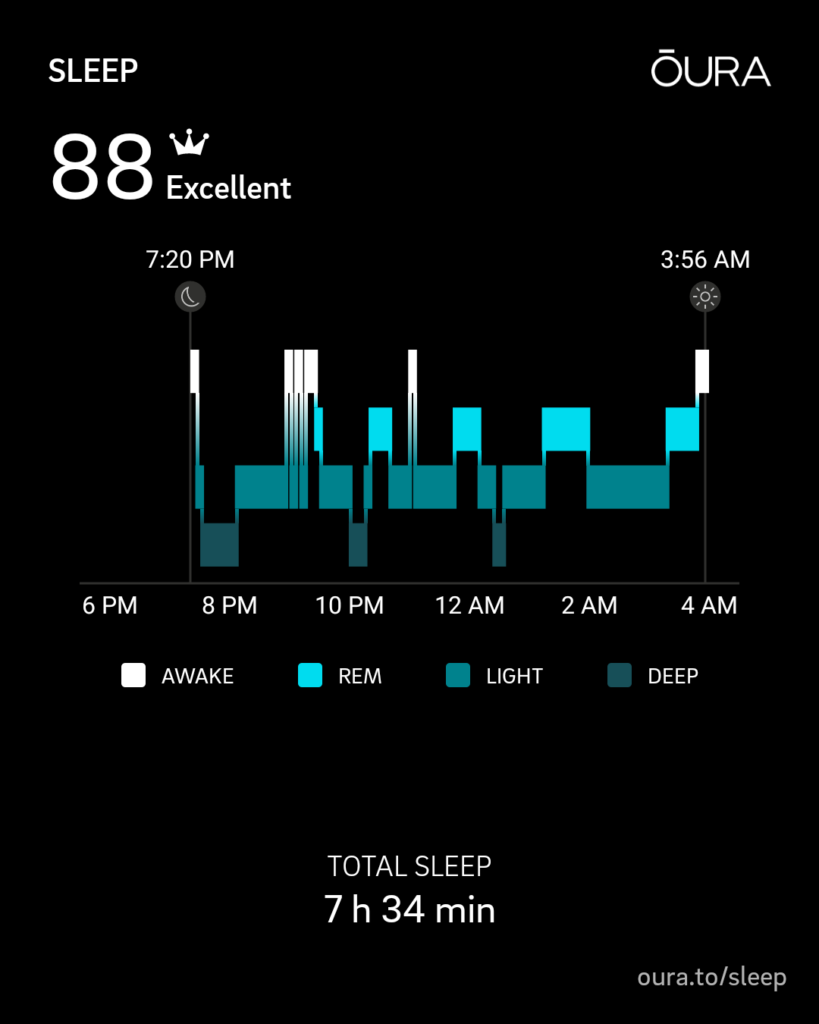
After sleeping poorly the previous night (stress), and being sleepy all afternoon, I went to bed really early last night and got in a excellent night’s sleep, including 56 minutes of deep sleep—well above average for me.


After sleeping poorly the previous night (stress), and being sleepy all afternoon, I went to bed really early last night and got in a excellent night’s sleep, including 56 minutes of deep sleep—well above average for me.

I am a little too prone to use black humor to distance myself from the depressing effects of the long, cold darkness of winter, which sometimes leaves people worrying about me unnecessarily. So I thought I’d mention that despite a bit of anxiety over the inevitable turn of the seasons, my mood is currently pretty great.
Beyond just feeling good right now, I’m hopeful. Over the past decade I’ve been handling winters better and better.
The biggest factor, I think, is that I no longer have a job to lose, so I no longer get into the spiral where seasonal depression makes me less productive, making me anxious about losing my job, making me more depressed, making me even less productivity. Sadly, advising others to take advantage of this strategy is not very useful (although I do and will continue to support and advocate for either a citizen wage or a guaranteed job).
Putting early retirement aside as impractical for most people, I thought I’d briefly summarize my other current practices—mostly ordinary coping strategies—both as a reference for myself any time I start to feel my brain chemicals coming on, and perhaps as a resource for other people. Here’s what’s working for me:
I have a few new possibilities up my sleeve:
That’s what I’ve got at the moment, but I’m always on the lookout for things to alleviate seasonal depression.
After yesterday’s Urbana Art Fair and a good night’s sleep last night, I was feeling pretty good. But a 20-minute walk in the prairie with my sweetie has me feeling so much better!
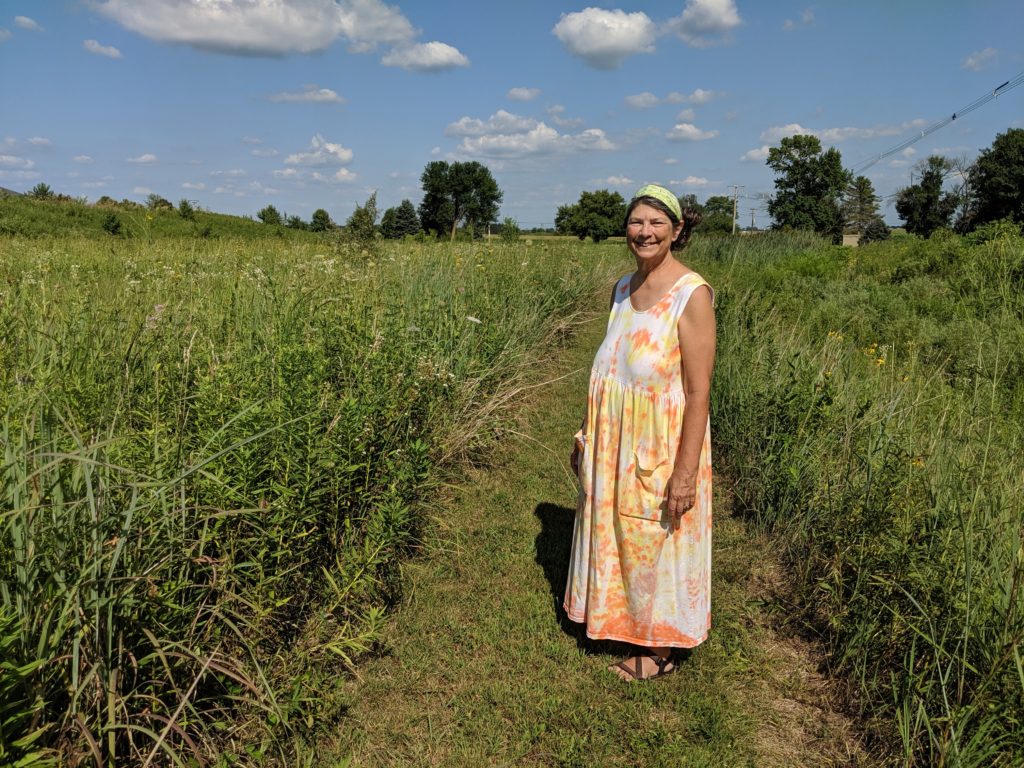
For an article in the New York Times, technology writer Brian X. Chen wore a sleep-tracker for a couple of weeks. He reports:
Ultimately, the technology did not help me sleep more. It didn’t reveal anything that I didn’t already know, which is that I average about five and a half hours of slumber a night. And the data did not help me answer what I should do about my particular sleep problems. In fact, I’ve felt grumpier since I started these tests.
Source: The Sad Truth About Sleep-Tracking Devices and Apps
Breaking news: Looking at your power bill every month does not cut your electricity consumption! Checking your speedometer does not slow down your car! Tracking your spending does not make you rich!
I’ve been using a sleep tracker (the Oura ring) since December. Neither wearing the ring nor checking the reports I get has increased the amount of sleep I got. However, I have learned a lot about how to get more and better sleep.
Probably the most useful thing I’ve learned is that the standard advice that you should have supper at least three hours before bedtime isn’t sufficient for me: I sleep much better if I finish supper at least four hours before I lie down to go to sleep.
That’s actually a specific example of my larger point: A sleep tracker makes it easy to run little experiments and quickly see the results.
My intuition as to whether I got a good night’s sleep is an excellent guide (as I suspect it is for most people). But even a good intuition isn’t always enough to run a good experiment, and this is an example of that. Although the Oura ring’s report isn’t better than my own intuition, it provided some specific information that led me to that particular insight: On days when I had a late supper, my sleep quality was quite poor for the first couple hours of sleep, a pattern that I didn’t see on days when I had an early supper.
I’ve used it to run other experiments. For example, it appears that I get more deep sleep on days when I have only one drink than on days when I have two. (This is very sad news, and will have to be confirmed by many more experiments before I use it to modify my behavior—but at least I can run the experiments.)
After a rough patch last fall (which is what prompted me to order the Oura ring), I’m actually sleeping pretty well now, so I’m not aggressively running new experiments to try and improve my sleep. I am, however, paying attention when a natural experiment presents itself. For example, we generally sleep with the windows open all summer. Over the next two nights that will probably produce sleeping temperatures in the 70s, whereas over following several nights I’ll get to enjoy sleeping temperatures in the 60s. I know from experience that the cooler temperatures will produce better sleep, but the Oura ring will give me detailed metrics that will let me investigate if there’s an optimal temperature—information that may be very useful in the winter for deciding how to adjust the thermostat.
That’s the value of the ring for me: It lets me run experiments of specific sleep interventions, and gives me results that are more fine-grained than just a general sense as to whether I slept well or not.
Here’s one more natural experiment. I observed decades ago that I need more sleep in the winter than I do in the summer. I can now put a couple of numbers on that.
Here’s my total sleep each day in January and February this year. The report from the Oura ring lets me see that I averaged 7 h 50 min of sleep each night:
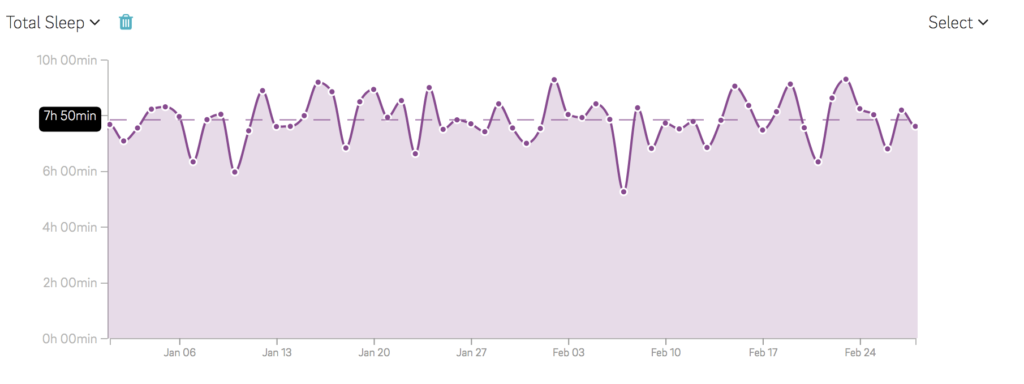
Here’s my total sleep each day from June 1st through last night. I can see that I averaged 7 h 03 min of sleep each night:
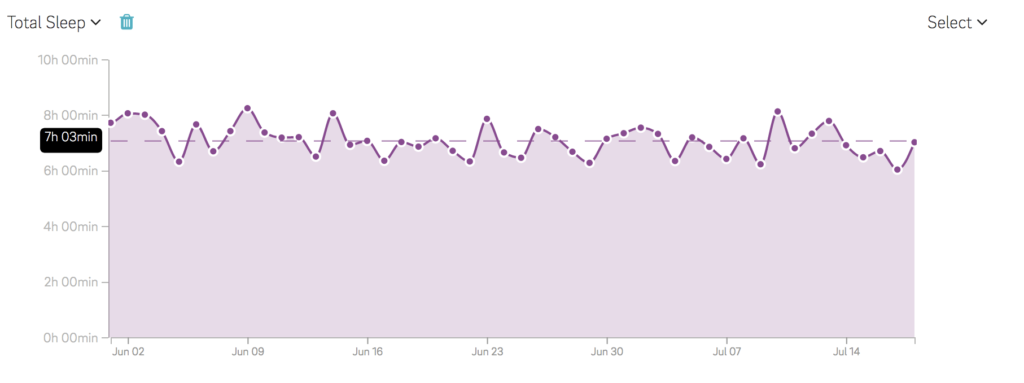
I’ve perceived each period as being roughly equally good in terms of getting “enough” sleep, so I’m inclined to think of the 47 minute decrease in sleep as being a decrease in the amount of sleep I need when the days are long and sunny and I’m getting plenty of fresh air and exposure to nature. In the winter I need darn near 8 hours of sleep per night. In the summer I can get by fine on just over 7.
That information doesn’t make me sleep better, but it’s still useful (even if it just confirms something I’ve known for a long time).
In other breaking news recently published in the science journal “Duh!”: Stepping on the bathroom scale every morning neither increases your muscle mass nor reduces your fat mass!
For a week now, the forecast has been that yesterday would be the first really nice day of the season, and I had decided a week ago that I’d go for a long run.
I tried to set everything up for good readiness, with a medium run back on Monday (so it wouldn’t be too long between runs), and then ordinary amounts of walking on Tuesday through Friday.
However, it wasn’t to be. I felt weak and sluggish right from the start, and found that even just maintaining a slow pace required that I ramp up my heart rate as the run went along:

(All that stuff in the yellow is too high, which is basically the whole run. I kept it almost in the green for the first mile, but after that it was way too high the whole time. The tiny bit where it spiked up into the red at the end was when I was sprinting to the button to get a walk signal.)
I have to say that my Oura ring warned me that my readiness was only so-so yesterday:
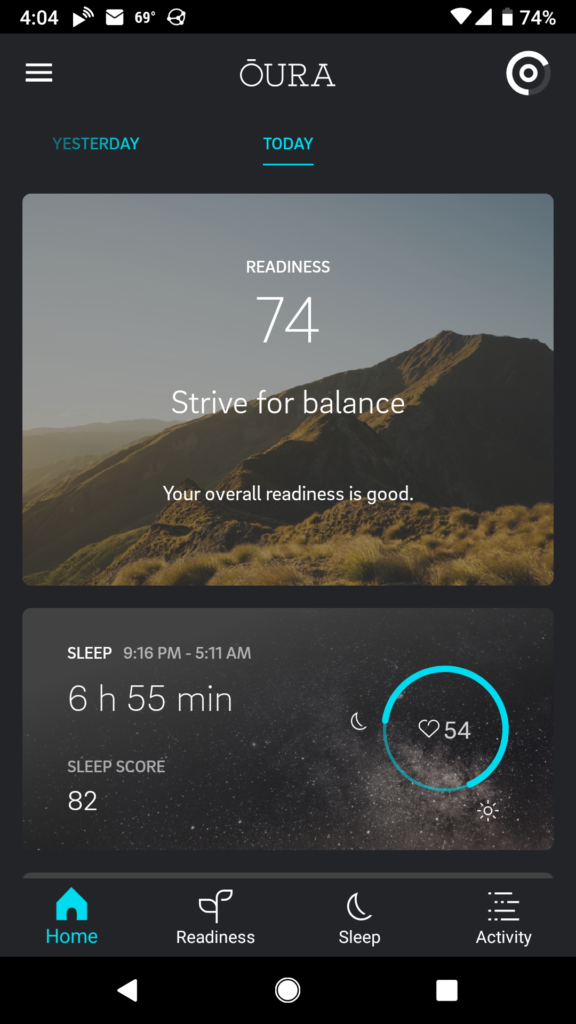
The main negative contributors, from the Oura ring’s perspective, were a mediocre night’s sleep, and a slightly elevated resting heart rate—and in particular, a resting heart rate that took most of the night even to settle down to that slightly elevated level (the “recovery index” part):
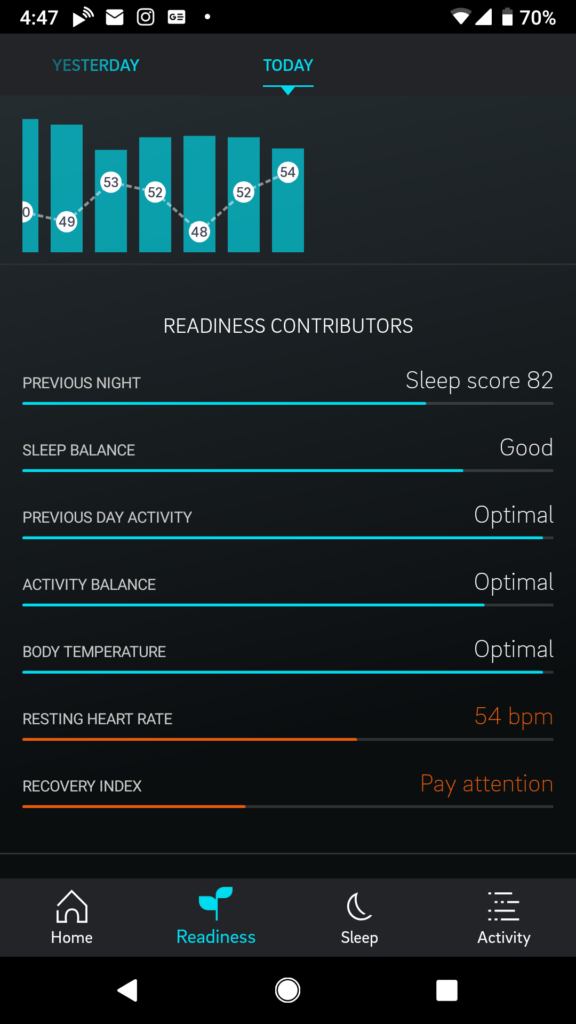
Last night my sleep was much better:
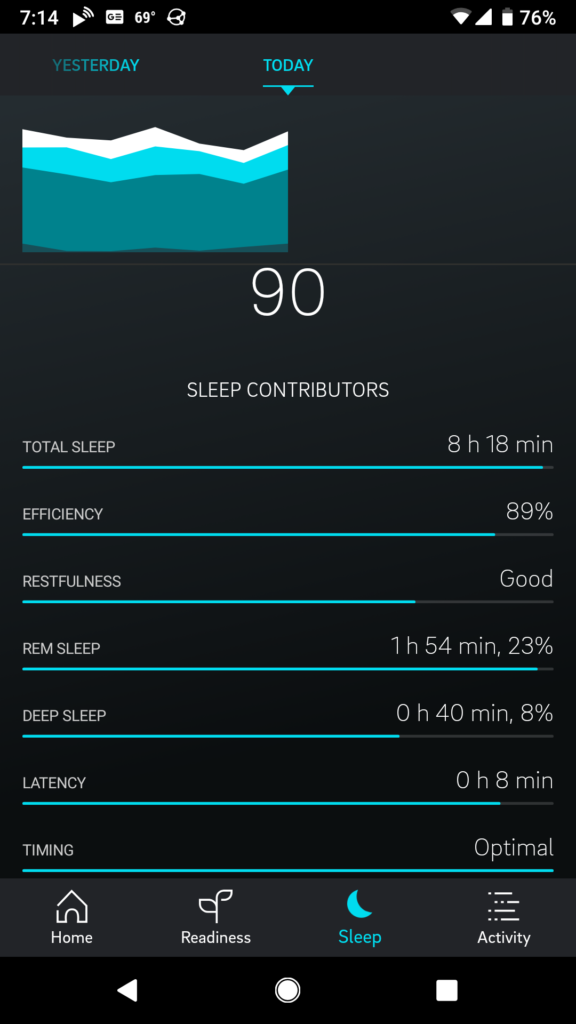
But it didn’t lead to a much higher readiness today, because yesterday’s run, even though it was a pretty feeble effort, was enough to mean that today I should at least somewhat take it easy:
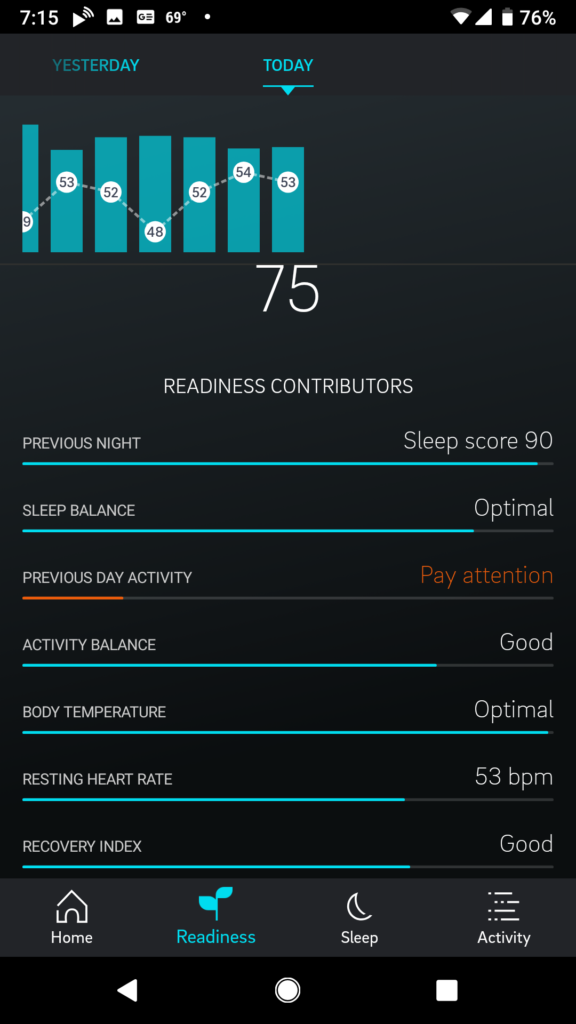
As it happens, I was pretty happy to do that. I got a reasonable amount of movement today, while nevertheless taking it pretty easy. Included in the day’s movement was the first bit of barefoot walking of the season. I also spent just a few minutes punching the heavy bag, mainly to get some photos for an Esperanto blog post on one aspect of my summer training plans.
As a big ol’ data geek, I’m by default interested in any metrics that I can get, especially ones related to me.
One of the metrics tracked by the Oura ring is body temperature, which is a metric don’t normally pay much attention to unless I think I might be sick, and I haven’t wanted to get sick just to explore this feature of the Oura ring. But a couple of days ago I did something much better: I got my shingles vaccination.
(I’ve been trying to get my shingles vaccination for months now, since they changed the recommended age from 60 to 50 and my insurance company started covering it for young folks like me. But with all the younger boomers thinking the same thing, the vaccine became scarce. Jackie and I finally tracked down shots last week.)
My immune system viewed the shot as something of a stern challenge, and sure enough my body temperature became elevated. In the graph below observe the last three data points, which show a spike to 0.7℉ above my baseline, followed by a 0.6℉ elevation the second night. Last night was only 0.3℉ above the baseline and back down in the normal range. (Near the middle you can see another spike to 0.7℉ above baseline followed by a negative deviation of a similar amount. That excursion was, I think, related to life stress.)
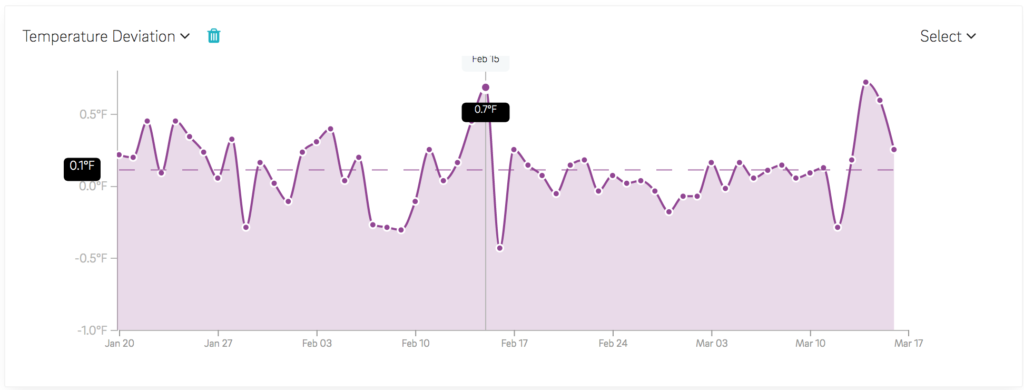
Observing that I was under some stress, the ring has been advising me to take it easy for the past couple of days. Knowing that the stress in question was a healthy one, I didn’t take the warning too seriously. The weather was nice the day after the shot, so I went out for a run, despite my ring’s advice.
Despite disregarding that particular day’s advice, I’ve actually been paying rather close attention to the ring’s indications as to my readiness. For example yesterday, when my body temperature and other factors suggested that I was still not recovered, I did take it easy—and I have been rewarded with an excellent night’s sleep and a moderately high readiness score for today:
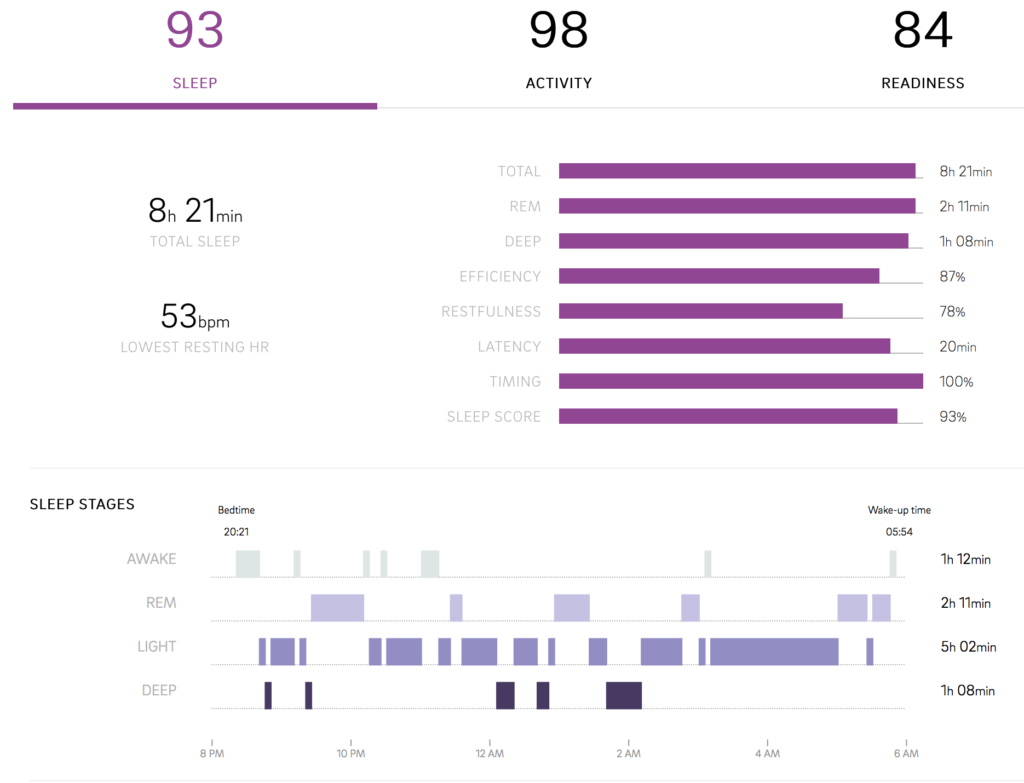
Perhaps today will be a good day for a long walk. By the middle of the week we’ll have some more excellent running weather, and hopefully I’ll be ready for it.
Of the many good things about spring, about now is when the lightening sky starts providing useful cues for waking up. If it’s still dark, I don’t need to check the time and can just go back to sleep. And if it’s getting light outside, it’s time to get up.
For a couple of years now, I’ve been having some trouble sleeping. It’s not a constant problem, but it has become more frequent than the rare thing it used to be.
I think the problem is just a string of one-off instances of stress. During this period I had one older relative begin having cognitive difficulties and have to move to a facility that could provide additional care, my cat got sick and eventually died, had some personality clashes related to volunteer work I’m doing grow into a problem that eventually involved lawyers, and had another older relative began showing signs of cognitive difficulties.
Each of these resulted in a pattern where I’d fall asleep just fine, but then wake up in the middle of the night and start ruminating about the issue of the day and be unable to fall back to sleep for an hour or three.
In the past when I had problems of this sort they tended to be short-lived. I’d stress out about something for a night or two or three, but the issue would be resolved soon enough and I go back to sleeping fine.
Here the issues have stacked up, new ones following the old ones. Further, some of them don’t go away. They linger on.
As I say, I think that’s what’s happening here. Ordinary life stresses have simply come at me a little too hard and a little too fast, with the result that my sleep has been impacted.
However, maybe that’s not all that’s going on. Maybe there’s more to it. I know there are some other issues. For example, if I don’t keep my carb intake down my nasal congestion returns, and that dramatically interferes with my sleep.
Given that I’m not sure what all might be wrong, I thought it might make sense to investigate further—gather some data, and see if I couldn’t find some patterns in my sleep problems. To that end, I bought an Oura ring, a tracking device along the lines of an Apple watch or a Fitbit, but with its focus specifically on gathering and analyzing data about sleep.
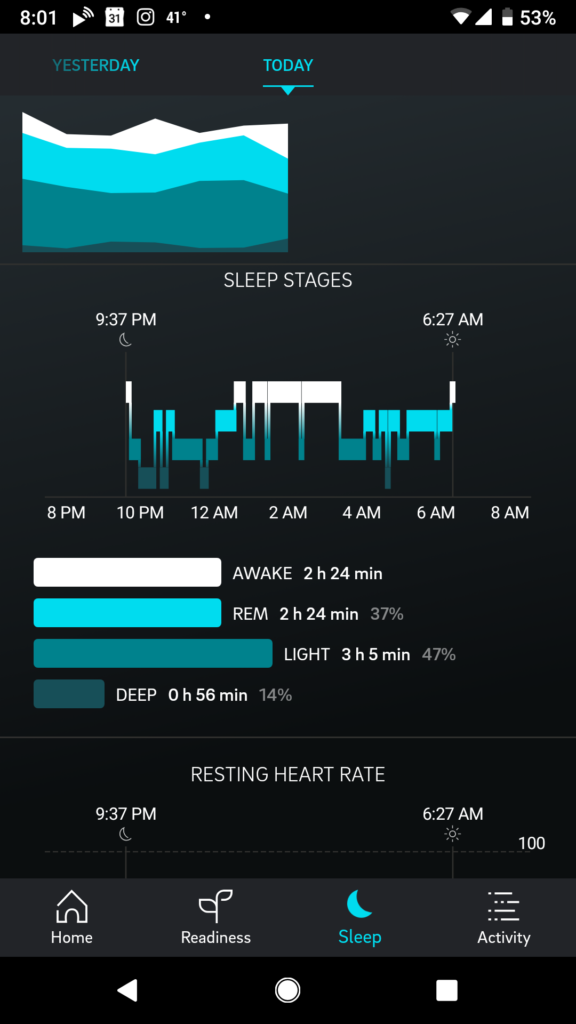
I’ve only had it for a week so far, and I’m really just getting started at looking for trends in the data. For example, three nights ago I slept poorly (awake for almost 2.5 hours of the almost 9 hours I was in bed).
One possible reason was a too-large meal too late in the day. (It was the Winfield Village holiday party.) One piece of data that suggests that possibility is that my body temperature was elevated by 0.3℃ during the night—perhaps because of increased metabolic activity digesting all that food.
Interestingly, I got more deep sleep than I had all week up to now, perhaps because I went for a long run the day before. (Deep sleep is where you get the physical recovery from things like heavy weight-lifting sessions and long runs. Maybe the first few nights had less deep sleep simply because I didn’t need more than that, because I hadn’t had the hard workouts that require deep sleep for recovery.)
Here’s the next night, where I spent less time awake and almost as much time in deep sleep:
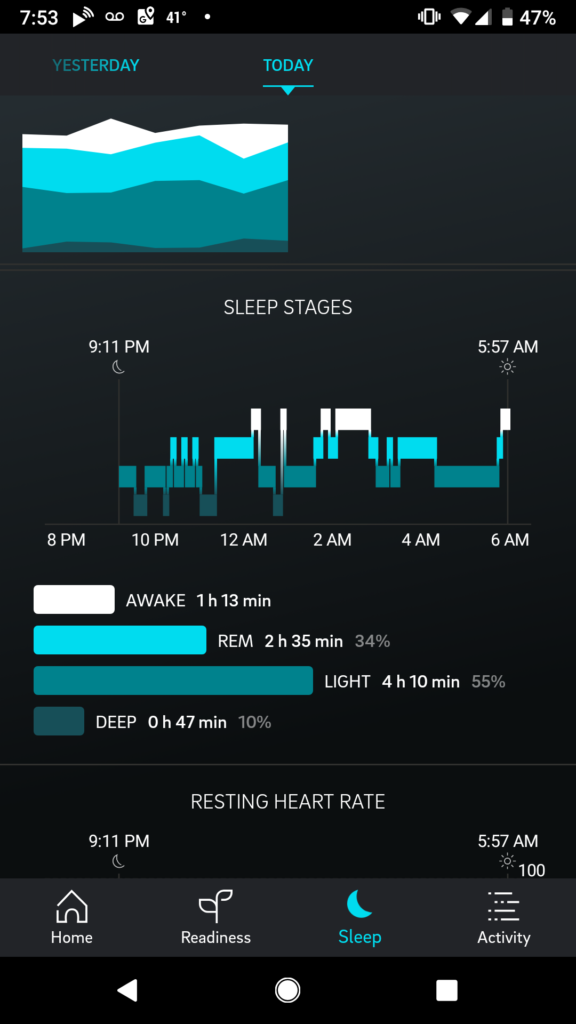
My body temperature was still up, though, even without the big meal. We had turned the thermostat down one more degree, but that’s about as low as we want it, so last night I rearranged the covers, removing the down comforter, going with just the wool blanket. I don’t know if that was a key change, but I slept very well last night:
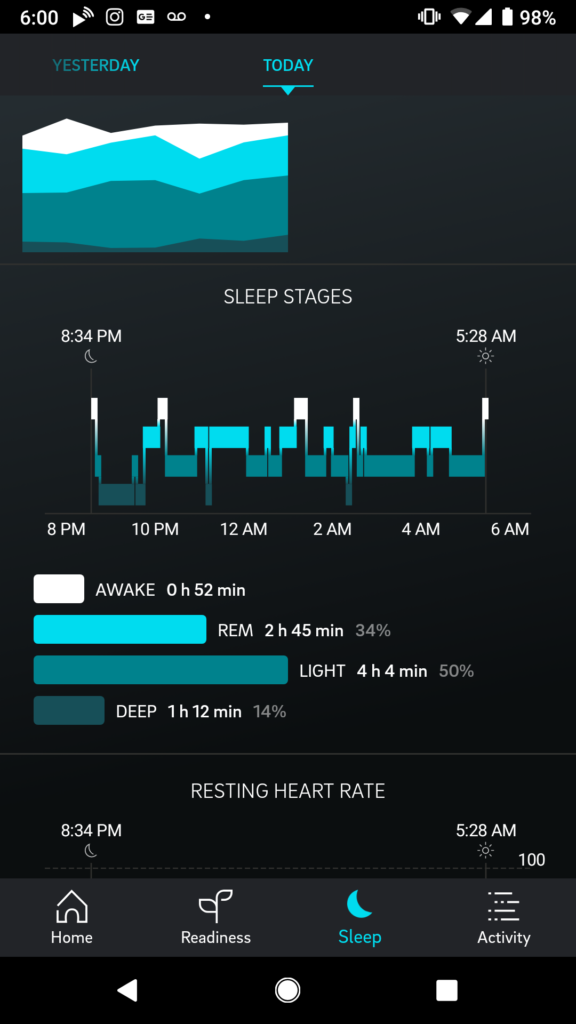
Not only were my quantities of total sleep and deep sleep good, some of the other metrics were good as well. My temperature deviation was -0.3℃, which suggests that maybe I’ve got the covers and thermostat thing balanced just about right. My resting heart rate was down to 47, which suggests that I’ve recovered completely from the long run I took three days ago.
My hope is that by paying attention to this sort of thing, I can gradually eliminate these sorts of problems affecting my sleep. Of course that will leave me with the stress-related problems, but I think I know how to handle those—fixing the ones that can be fixed, accepting the ones that can’t be fixed, and engaging in appropriate self-care to help myself handle the stress better. And, of course, get enough sleep.
I think it’s a good marker for well-being to wake up feeling like jumping out of bed. That doesn’t mean there’s anything wrong with sometimes waking up and feeling like lazing in bed for a while.
I’ve slept late the past two days—until after 7:00 AM. (That might not seem late to you, but it’s late for me. Also, I’d gone to bed early both evenings, before 9:00 PM, so we’re talking a solid 10 hours of sleep each night.)
This usually means stress. When I’m under stress, I need more sleep.
It’s not necessarily stress. The time just changed, and it may simply be that I’m sleeping until dawn, as I always do. Checking the almanac, sunrise today was at 7:07 AM. So that’s actually a pretty strong contender. Maybe I’m worrying about nothing.
Still, over the years, I’ve noticed that needing extra sleep is often an early sign that I’m under stress. In fact, it’s often the first sign. More than once, it has been greatly to my advantage that I noticed the oversleeping early, and used that clue to spot the sources of stress that had been accumulating at levels just beneath my notice. It let me address them before they blew up into problems. (Another early sign is getting annoyed at bad drivers around me. When other people’s bad driving starts aggravating me, it almost always means I’m actually stressed about something else entirely. That symptom has not yet appeared.)
So, because of my history with spikes in the need for sleep when I’m under stress, I’m looking around for possible stressors. There are plenty. I’ve got a bunch of things to do (the taxes, renewing my passport). Progress on the novel remains slow as I continue plowing through the already-written part. We just got notified that the new owners of the apartment complex are raising the rent by a lot (and want to charge for a bunch of stuff that was previously included in the rent, which would be okay except that the infrastructure to meter that stuff doesn’t exist, so they’d just be making up numbers). Finances are perennially tight, with returns to capital being what they’ve been since 2007.
So, I’ll take steps to address a bunch of those. A few are very small tasks, and have only been put off because they’re multi-step projects (get picture, fill out form, send it in) and I haven’t been organized to get all the steps taken care of. Others, such as investigating other apartments, are obviously huge sinkholes of time.
Stress is cumulative. Hopefully, taking care of some of the little things promptly can free up some energy to take care of the big things more calmly.